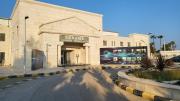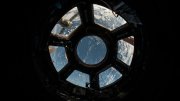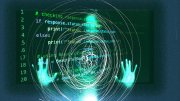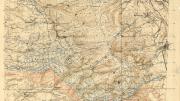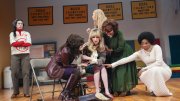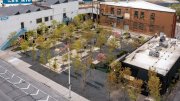“Open, sesame!” This phrase, familiar from childhood stories, comes from Antoine Galland’s translation of One Thousand and One Nights. In the story, it is spoken to open the mouth of a cave enclosing untold magical treasures. Like Ali Baba to the cave, His Majesty King Abdullah II of Jordan officially declared the SESAME laboratory open to new member countries in 2017—an initiative lending hope today to a Middle East torn by war.
With devastation still raging along the Gaza Strip, Baird professor of science Lisa Randall is passionate about the mission behind SESAME (the Synchrotron-light for Experimental Science and Applications in the Middle East): an intergovernmental organization based in Allan, Jordan, with Cyprus, Egypt, Iran, Israel, Jordan, Pakistan, and Turkey among its member countries, and including scientists from Palestine.
Randall’s research focus is connecting unsolved questions in theoretical particle physics to the properties and interactions of matter. She is also the author of several books designed to bring science and ideas about science to the general public, including Warped Passages: Unraveling the Mysteries of the Universe’s Hidden Dimensions (2005—reviewed here) and Dark Matter and the Dinosaurs (2015).
In this interview for Harvard Magazine, Randall discusses the goals of SESAME, the first synchrotron light source in the Middle East (one of about 60 such facilities worldwide), against the backdrop of the Israel-Palestine conflict—both as it has been reflected on the Harvard campus and, more broadly, in terms of the conflicting ideas themselves.
“You see that people are having trouble talking to each other,” Randall comments—a mild way of describing the divisions that have ruptured the Harvard campus, as seen in news headlines and this latest, deadly iteration of the Middle East conflict. “People are angry. Some of it is displaced anger about other issues. And so I really like the idea of sort of finding common ground [in science], finding diversions in some sense for people to think about. So rather than trying to just directly solve all these issues, get people who can develop some trust with each other.”
As background to Randall’s comments and her work: Synchrotrons, particle accelerators designed to produce high-energy beams of light, have applications in fields ranging from medicine, atmospheric research, and clean combustion and industrial production, to agriculture.
As described in its statues, “SESAME shall provide for collaboration in the Middle East and the Mediterranean Region with free access to all scientists of SESAME members in relevant areas of research, being also open to scientists from the whole world, in basic and applied research using synchrotron radiation or closely related topics.” The organization was brought together by researchers from CERN, the European Organization for Nuclear Research, to provide an environment promoting both scientific research and peace initiatives. Like CERN, it was developed under the auspices of the United Nations Educational, Scientific and Cultural Organization (UNESCO).
In an essay entitled “From dreams to beams: SESAME’s 30 year-long journey in science diplomacy,” Eliezer Rabinovici, the president of the CERN Council and twice-elected vice-president of the SESAME Council, reflected:
The story of SESAME started at CERN 30 years ago. One day in 1993, shortly after the signature of the Oslo Accords by Israel and the Palestine Liberation Organization, the late Sergio Fubini, an outstanding scientist and a close friend and collaborator, approached me in the corridor of the CERN theory group. He told me that now was the time to test what he called “your idealism,” referring to future joint Arab-Israeli scientific projects.
CERN is a very appropriate venue for the inception of such a project. It was built after World War II to help heal Europe and European science in particular. Abdus Salam, as far back as the 1950s, identified the light source as a tool that could help thrust what were then considered “third-world” countries directly to the forefront of scientific research.
Randall compares the moment to English astronomer Arthur Eddington’s (1882-1944) proof of Einstein’s theory of light, set against the rising tensions of World War I. “Part of his goal as a British scientist,” Randall explained, “was to show that the theory of a German physicist could be correct.” The war interfered with dissemination of Einstein’s ideas and work, but a series of detailed primers made their way to Eddington’s desk through a network of Cambridge University friends. Eddington, a Quaker and conscientious objector to the war, believed that wartime resentments were affecting the progress of science. Opposing Newtonian theory—that space was static and gravity as a force acted through space but not on it, so light could only travel in straight lines—Einstein postulated that gravity is a force resulting from spacetime. Accordingly, he believed that the sun’s massive gravitational field would warp spacetime itself, bending light. Eddington agreed. One year after the armistice that ended World War I, Eddington announced his team’s research findings proving Einstein correct.
Thus an Englishman extolled the ideas of a German scientist, even as England and its allies endured the German onslaught.
In the fraught present, Randall similarly emphasizes the role of science as an equalizer and a uniting force—perhaps the most neutral force for breaking down barriers between conflicting ideologies or warring rivals to explore reality. Even as air strikes continue to raze parts of Gaza, scientists at SESAME, including both Israelis and Palestinians, together examine clues to the fundamental nature of the universe.
“Let me be clear, [SESAME] was founded not just for political missions,” Randall concludes. “I mean, there's just amazing science. And because these countries are working together, they can do this project that none of the countries individually on their own could have done.”
One might call the synchrotron, and the organization within which it operates, Milyunanochesco: a Spanish adjective meaning “thousand-and-one-nights-esque,” as also elaborated by the author Jorge Juis Borges in the essay The Translators of The Thousand and One Nights. Like the sorceries within Galland’s classic tale, the SESAME synchrotron performs magic in its simultaneous pursuit of advanced experimental physics and human cooperation in face of political and military differences.
